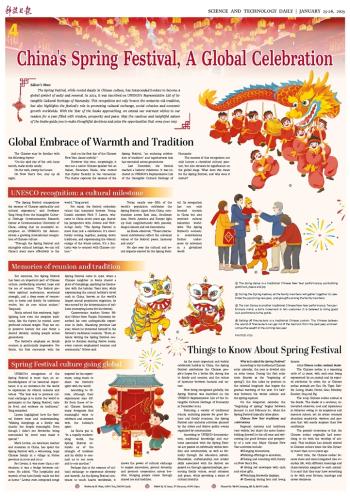
The Chinese may be familiar with the following rhyme:
"On the 23rd day of the 12th lunar month, make sticky candy;
On the 24th, sweep the house;
On New Year's Eve, stay up all night;
And on the first day of the Chinese New Year, dance joyfully."
However this time, surprisingly, it was not a native Chinese speaker but an Italian, Francesco Faiola, who recited this rhyme fluently in the vernacular. The rhyme captures the essence of the Spring Festival, "an enduring celebration of tradition" and togetherness that has resonated across generations.
Last December, the festival reached a historic milestone. It was included in UNESCO's Representative List of the Intangible Cultural Heritage of Humanity.
The success of this recognition not only honors a cherished cultural practice, but also elevates its significance on the global stage. What does this mean for the Spring Festival, and why does it matter?
UNESCO recognition: a cultural milestone
"The Spring Festival encapsulates the essence of Chinese spirituality and cultural expression," said Professor Yang Hong from the Intangible Cultural Heritage Communication Research Center at Communication University of China, adding that its successful inscription on UNESCO's list demonstrates a growing international recognition of Chinese culture.
"Through the Spring Festival and intangible cultural heritage, we can tell China's story more effectively to the world," Yang noted.
For many, the festival embodies values that transcend borders. Young Danish scientist Nick Y. Larsen, who came to China seven years ago, shared his perspective with Science and Technology Daily. "The Spring Festival is more than just a celebration. It's about family coming together, passing down traditions, and experiencing the vibrant energy of the whole nation. It's a fantastic way to connect with Chinese culture."
Today, nearly one-fifth of the world's population celebrates the Spring Festival. Apart from China, communities across East Asia, Southeast Asia, North America and Europe light up their neighborhoods with parades, dragon dances and red decorations.
As Faiola observed, "These international celebrations reflect the universal values of the festival: peace, harmony and unity."
He also sees the cultural and social impacts exerted by the Spring Festival. Its recognition has not only boosted tourism in China but also enriched cultural industries worldwide. The Spring Festival's economic contributions further underscore its relevance in a globalized world.
Memories of reunion and tradition
For centuries, the Spring Festival has been an important part of Chinese culture, symbolizing renewal, hope and the joy of reunion. "The festival provides spiritual sustenance, emotional strength, and a deep sense of connection to home and family. Its traditions evolve, but its core values endure," Yang said.
Faiola echoed this sentiment, highlighting how even the simplest traditions, like the rhyme he recited, carry profound cultural weight. They not only preserve history but also foster a shared identity, uniting people across generations.
The festival's emphasis on family reunion is particularly impressive. For Faiola, his first encounter with the Spring Festival came in 1996, when a Chinese neighbor in Rome shared a plate of dumplings, sparking his fascination with the holiday. Years later, while experiencing the annual holiday's travel rush in China, known as the world's largest annual population migration, he was moved by the determination of millions journeying home for the festival.
Cameroonian teacher Kenne Michel Olivier from Tianjin University described his own unforgettable experience in Qufu, Shandong province last year, where he immersed himself in the festival's traditional customs. "From artisans writing the Spring Festival couplets to families sharing festive meals, every custom emphasized reunion and community," Olivier said.
Spring Festival culture going global
UNESCO's recognition of the Spring Festival is more than an acknowledgment of its historical importance; it is an invitation for the world to experience its vibrant customs and values. "The best way to promote cultural exchange is to invite the world to participate in the Spring Festival, taste its food, and embrace its traditions," Yang remarked.
Larsen highlighted how the festival fosters trust and understanding. "Making dumplings as a family was chaotic but deeply meaningful. Even though I didn't see fireworks, being surrounded by loved ones made it special."
Mark Levine, an American teacher and musician in China, has spent the Spring Festival with a welcoming, large Chinese family in a village in Hubei province in 2009 and 2010.
For Levine, it was more than a celebration; it was a bridge between cultures. He added, "The hospitality and warmth of my host family made me feel at home." Levine even composed songs inspired by his experiences, using music to share the festival's spirit with the world.
According to Olivier, although their experiences may differ from those of local Chinese families, many foreigners find meaningful ways to celebrate and connect with the holiday's spirit.
As Faiola put it, "In a rapidly modernizing world, the Spring Festival reminds us of the strength of tradition and its ability to connect us to our roots and to one another."
Perhaps this is the essence of cultural exchange: to experience diversity and warmth. As the Spring Festival continues to touch hearts worldwide, it shows the power of cultural exchange to inspire innovation, protect diversity, and promote cooperation across borders, bringing people closer through shared joy and tradition.







